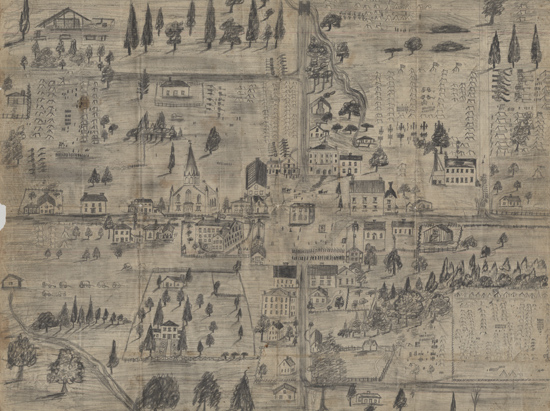Andrew Tinkham Papers

Image courtesy of Wilson’s Creek National Battlefield
Andrew Tinkham enlisted May 25, 1861, as a private in Company F of the First Kansas Infantry, which was organized at Fort Leavenworth, Kansas, between May 20 and June 3, 1861. Unlike other volunteer troops which fought at Wilson’s Creek, the Kansans were not uniformed by their home communities.1 The men marched to Kansas City, Missouri, and then joined Gen. Nathaniel Lyon in Clinton, Missouri. They were attached to Col. George W. Dietzler’s 4th Brigade, which was part of Lyon’s Army of the West. In July 1861, the First Kansas Infantry advanced on Springfield, Missouri. On August 2, 1861, they participated in the Battle of Dug Springs, and then eight days later, they fought in the Battle of Wilson’s Creek.
Tinkham drew two maps. The first map depicted Springfield and the second was of the Battle of Wilson’s Creek. Tinkham’s Springfield map provided an aerial view of the town. He noted building names and the position of soldier’s encampments. He sent the Wilson’s Creek map to his brother, David Tinkham, with a letter on the back.
Andrew Tinkham’s Drawing of Wilson’s CreekI send you a picture of the battle of Wilsons C, just at the time I was shot when our battery had a making fire on the rebels the cannon on the left is tottems battery the first reg is the 1st Kansas next is 2nd Kansas next is the missouri boys when we retreated we marched right back over the hill back of the battery…
Andrew Tinkham letter to David Tinkham – n.d.
Image courtesy of Wilson’s Creek National Battlefield
During the Battle of Wilson’s Creek, at about 6 a.m., as Gen. Lyon’s 1st Kansas Infantry and the 1st Missouri Infantry crested what became known as “Bloody Hill”, they were slowed by fire from the Pulaski Arkansas Battery. During the battle, they fixed bayonets and charged the Confederate line. The First Kansas Infantry held the left side of the hill, while Capt. James Totten’s Battery formed the center of the Union line. The First Kansas formed on the right side of the First Iowa Infantry, and the First and Second Missouri regiments promptly filed into line to the right of the First Kansas. Captain Totten placed his guns in the rear of the First Missouri Infantry. The Second Kansas Infantry was held in reserve some distance in the rear of the line of battle.
An unknown soldier from Company G of the First Kansas Infantry wrote a letter a month after the Battle at Wilson’s Creek, detailing the events and the efforts made by his unit.
Then the order came- Kansas First [1st Kansas Infantry] to the front!” and with one good hearty cheer, the regiment rose to its feet. As we advanced, the gallant Missouri First [1st Missouri Infantry] fell back.2
Unknown Soldier’s letter – September 6, 1861
After the battle, Union troops retreated back to Springfield, and then fell back to the railhead at Rolla, Missouri. During service, the regiment had 7 officers and 120 enlisted men killed or mortally wounded, plus 3 officers and 122 enlisted men die by disease, for a total lost of 252.
Andrew Tinkham survived the war, married Elizabeth and had one son, Andrew Tinkham, Jr. He lived in Wellington, in Sumner County, Kansas, where he worked as a shoemaker.3 Tinkham died November 9, 1909. Elizabeth passed away in December 1926, and was buried next to her son at the Prairie Lawn Cemetery in Sumner County, Kansas.4
Contributed by Wilson’s Creek National Battlefield
- William Garrett Piston and Richard W. Hatcher III, Wilson’s Creek: The Second Battle of the Civil War and the Men Who Fought It (Chapel Hill, NC: The University of North Carolina Press, 2000), pg 65.
- Richard W. Hatcher III and William Garrett Piston, Kansans at Wilson’s Creek: Soldiers’ Letters from the Campaign for Southwest Missouri (Springfield, MO: Wilson’s Creek National Battlefield Foundation, 1993), pg 87.
- 1880 Federal Census; Census Place: Wellington, Sumner, Kansas; Roll: 398; Family History Film: 1254398; Page: 271D; Enumeration District: 211; Image: 0555.
- “Elizabeth Marcella Tinkham”, Find A Grave, http://www.findagrave.com/cgi-bin/fg.cgi?page=gr&GSln=Tinkham&GSiman=1&GScid=93428&GRid=61296516&















